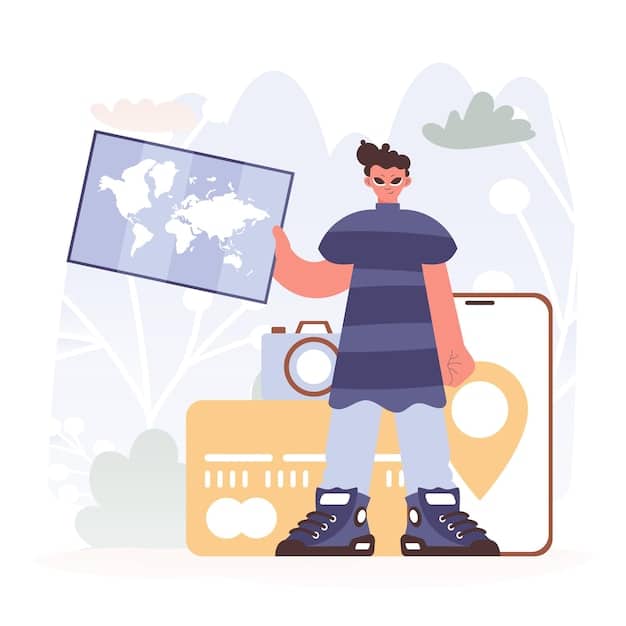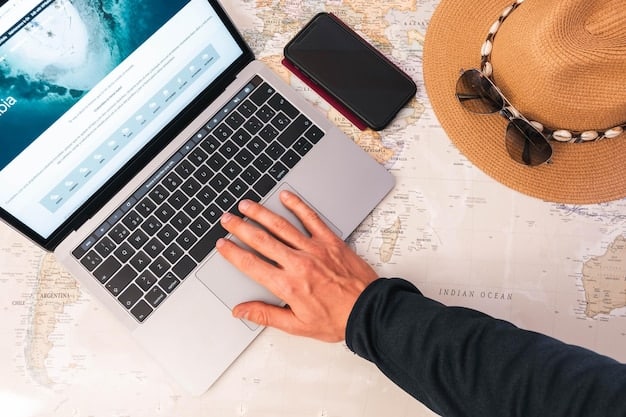Never Pay Full Price Again: Your Guide to Travel Hacking Discounts

Anúncios
Unlocking significant savings on travel is entirely possible through strategic travel hacking, a methodology that leverages loyalty programs, credit card points, and insider knowledge to secure deep discounts on flights, accommodation, and experiences, transforming dream trips into affordable realities.
Anúncios
Embarking on dream vacations no longer requires breaking the bank. The art of travel hacking offers a pathway to explore the world without paying full price, transforming aspirational journeys into tangible, affordable experiences. This comprehensive guide will unveil the insider strategies, tools, and mindsets you need to master discounted travel, making your next adventure more accessible than ever before.
The Basics of Travel Hacking: Beyond Coupons and Sales
Travel hacking isn’t simply about finding a coupon code or waiting for a flash sale; it’s a sophisticated discipline rooted in understanding how the travel industry operates and leveraging its mechanisms to your advantage. At its core, it’s about maximizing value, accumulating points and miles, and strategically redeeming them for flights, hotel stays, and other travel expenses at a fraction of their retail cost.
Unlike traditional budget travel, which often involves significant compromises on comfort or convenience, travel hacking aims to achieve premium travel experiences for less. This can involve anything from flying first class for the price of economy to staying in luxury resorts for mere pennies. The key is knowledge and consistent application of specific techniques, turning everyday spending into opportunities for future adventures.
Anúncios
Understanding Points and Miles Programs
The bedrock of travel hacking lies in loyalty programs offered by airlines, hotels, and credit card companies. These programs reward consumers for their spending, transforming purchases into redeemable points or miles. Different programs offer varying values and redemption options, requiring careful consideration to maximize their potential. Understanding the value of a point or a mile across various programs is crucial; a point with one airline might be worth significantly more than a point with another, depending on how you plan to redeem it.
- Airline Loyalty Programs: Earn miles by flying with an airline or its partners, using co-branded credit cards, or through shopping portals. Miles can be redeemed for flights, upgrades, or even car rentals.
- Hotel Loyalty Programs: Accumulate points by staying at a hotel chain, using their associated credit cards, or dining at their properties. Points are best used for free nights, but some offer unique experiences.
- Credit Card Reward Programs: Many credit cards offer their own points systems, which can often be transferred to various airline or hotel partners. These are incredibly versatile and form a cornerstone of many travel hacking strategies.
Credit Cards as a Gateway to Discounts
Specialized travel credit cards are arguably the most powerful tool in a travel hacker’s arsenal. These cards often come with generous sign-up bonuses, offering tens of thousands of points or miles just for meeting a minimum spending requirement. Beyond bonuses, they provide ongoing rewards for specific spending categories, travel perks like lounge access or free checked bags, and often transferrable points that unlock immense flexibility. The strategic opening and responsible management of these cards are pivotal to accumulating rewards quickly and efficiently.
It’s important to approach credit cards with discipline. The goal is to earn rewards, not to accrue debt. Always pay off your balance in full and on time to avoid interest charges, which would negate any savings from points. Research the best cards based on your spending habits and travel goals, looking for those that align with your chosen airlines or hotel chains, or those with highly flexible points systems that offer transfers to multiple partners.
In essence, mastering travel hacking is about becoming an informed consumer, navigating the complex world of loyalty programs and financial products with a clear strategy. It’s an ongoing learning process, but one that richly rewards those willing to put in the effort, opening doors to travel experiences once thought to be out of reach.
Mastering Credit Card Sign-Up Bonuses for Maximum Impact
The single most potent strategy in the travel hacker’s playbook is leveraging credit card sign-up bonuses. These are massive injections of points or miles offered by banks to new cardholders who meet specific spending thresholds within an initial period, typically 3-6 months. These bonuses can easily fund multiple international flights or several nights in luxury hotels, making them the quickest way to accumulate a substantial points balance.
To effectively utilize sign-up bonuses, a methodical approach is essential. This involves researching the best current offers, understanding the spending requirements, and planning how to meet them through your normal expenditures, without overspending or going into debt. Many experienced travel hackers coordinate their larger purchases, such as home repairs, medical bills, or even taxes, around new card applications to easily meet these thresholds.
Strategic Card Applications and Churning
Applying for multiple credit cards over time, a practice sometimes referred to as “churning,” can significantly accelerate your points accumulation. However, this strategy requires careful attention to your credit score and bank-specific rules. Banks often have restrictions on how frequently you can apply for new cards, or how many cards you can hold at one time. For example, Chase’s “5/24 rule” dictates that if you’ve opened 5 or more personal credit cards from any issuer in the last 24 months, you’re unlikely to be approved for most of their valuable cards.
- Understanding Credit Scores: While applying for new credit can temporarily slightly lower your score, responsible management (paying on time, keeping utilization low) will quickly mitigate this. Your score will generally recover and often improve over time as your credit history lengthens and you demonstrate responsible financial behavior.
- Bank-Specific Rules: Be aware of rules like Chase’s 5/24, American Express’s “once per lifetime” rule for sign-up bonuses on specific products, and others that might limit your eligibility for new bonuses. Staying informed helps avoid wasted applications.
- Annual Fees: Many premium travel cards come with annual fees. Evaluate if the benefits (lounge access, free nights, travel credits) outweigh the fee. Often, the value derived from the sign-up bonus alone can justify the fee for the first year. Some cards also offer credits that effectively offset or reduce the annual fee.
Meeting Minimum Spending Requirements Smartly
Meeting the minimum spending requirement doesn’t mean you need to buy things you don’t need. The goal is to funnel your existing, necessary expenses through the new card. This could include groceries, utility bills, insurance premiums, or even paying rent if your landlord allows. For larger expenses, consider using services like Plastiq, which allows you to pay bills normally not payable by credit card (like rent or mortgage) for a small fee, though always verify the fee doesn’t negate your bonus value.
Another often-overlooked method is offering to pay for group meals or purchases and having friends reimburse you in cash. This allows you to quickly rack up spending on your card for expenses you would already be making. Always track your spending carefully to ensure you meet the requirement within the specified timeframe. Missing the minimum spend means missing out on the bonus, which is the primary reason for getting the card.
By strategically navigating sign-up bonuses, understanding bank policies, and responsibly managing your credit, you can rapidly accumulate points and miles, paving the way for significantly discounted or even free travel experiences. This forms the foundation of all advanced travel hacking techniques.

Optimizing Redemptions: Maximizing the Value of Your Points and Miles
Accumulating a stash of points and miles is only half the battle; the true art of travel hacking lies in redeeming them for maximum value. Not all redemptions are created equal, and knowing when and how to use your hard-earned rewards can dramatically affect the perceived “discount” you achieve. This often involves understanding variable redemption rates, identifying sweet spots, and being flexible with your travel plans.
The face value of points and miles can fluctuate wildly depending on the program, the type of redemption, and even the specific route or date. A flight that costs 10,000 miles might be “worth” $100 if the cash price is low, giving you a 1 cent per mile valuation. However, if the cash price for the same flight spikes to $500, those same 10,000 miles are now worth 5 cents each, a significantly better redemption. The goal is always to aim for redemptions that yield a high “cents per point” (CPP) value.
Finding “Sweet Spots” in Award Charts
Many airline and hotel loyalty programs publish award charts, which dictate how many points are required for a particular flight or hotel stay. While some have moved to dynamic pricing, many still offer fixed-rate redemptions for certain routes or categories. These fixed rates often present “sweet spots” where the points cost is disproportionately low compared to the cash price, especially for premium cabins or long-haul flights. Researching these sweet spots and being prepared to book quickly when availability opens up is key.
- Partner Redemptions: Many airlines are part of alliances (Star Alliance, SkyTeam, Oneworld). You can often book flights on a partner airline using miles from another airline within the same alliance. This can reveal some of the best sweet spots, as the award charts of some loyalty programs are more generous for partner flights.
- Off-Peak Travel: Some loyalty programs offer reduced rates for travel during off-peak seasons or on less popular days. Being flexible with your travel dates can unlock substantial savings in points.
- Transfer Bonuses: Credit card reward programs occasionally offer bonuses when you transfer points to their airline or hotel partners. A 25% transfer bonus means 10,000 credit card points become 12,500 airline miles, significantly increasing the value of your initial points.
Avoiding “Bad” Redemptions
Just as there are sweet spots, there are also “bad” redemptions that offer poor value. These typically occur when the cash price of a flight or hotel is very low, making the points cost feel disproportionately high. For example, redeeming 10,000 points for a hotel room that costs only $80 might not be the best use of points, especially if those same points could be transferred to an airline partner for a flight worth $300.
It’s crucial to always compare the points cost against the cash price of the desired travel. If the cents per point value is low (e.g., less than 1.5 cents per mile for airline redemptions or 0.6 cents per point for hotel redemptions), it might be better to save your points for a more valuable redemption and simply pay cash for the current booking. Sometimes, saving points for a premium cabin redemption on a long international flight will yield the highest per-point value, even if it requires more points overall.
Furthermore, be wary of redeeming points for non-travel related items, such as gift cards or merchandise. These redemptions almost universally offer a much lower value than if the points were used for travel. The entire philosophy of travel hacking revolves around maximizing travel experiences, so funneling points towards anything else usually defeats the purpose of these highly optimized strategies.
Leveraging Travel Portals and Discount Websites
While points and miles form the backbone of travel hacking, there are many opportunities to secure discounts and enhanced value through strategic use of online travel agencies (OTAs), meta-search engines, and specialized discount platforms. These tools can help you find deals on flights, hotels, car rentals, and activities, often complementing your points strategies or providing viable alternatives when award availability is scarce.
The goal isn’t just to find the cheapest option, but the best value. This involves understanding how dynamic pricing works, utilizing price alerts, and searching across multiple platforms to ensure you’re getting the most bang for your buck. Sometimes the best deal isn’t directly on an airline’s website but through an aggregator, or vice versa, so an open-minded approach to booking channels is crucial.
Meta-Search Engines and OTA Strategies
Meta-search engines like Google Flights, Skyscanner, and Kayak are invaluable for comparing prices across multiple airlines and OTAs simultaneously. They allow you to explore flexible dates, track price changes, and identify routes with unusual price drops. Google Flights, in particular, is powerful for exploring destinations with an open mind, as you can search for the cheapest places to fly to from your home airport within a certain timeframe.
- Price Alerts: Set up price alerts on these platforms for specific routes and dates. You’ll be notified when prices drop, allowing you to snag a deal as soon as it appears. Flexibility with dates can amplify these savings significantly.
- Incognito Mode: While largely debunked for consistently lower prices, searching in incognito or private browsing mode might occasionally prevent websites from tracking your search history and potentially showing you higher prices based on perceived interest. It’s a low-effort habit worth adopting.
- Bundles and Packages: Sometimes, booking a flight and hotel bundle through an OTA can be cheaper than purchasing them separately. However, be cautious: booking through an OTA can sometimes complicate changes or cancellations compared to booking directly with the airline or hotel.
Flash Sales and Error Fares
Keep an eye out for flash sales and, more rarely, error fares. Flash sales are short-term promotions where airlines or hotels drastically reduce prices for a limited period. Subscribing to newsletters from travel deal websites and airlines is the best way to catch these. Error fares occur when an airline or OTA accidentally publishes an incorrect, extremely low fare due to a technical glitch or human error. These are rare and fleeting, often lasting only hours, but can lead to incredible savings if you act fast. Websites like Secret Flying or The Flight Deal specialize in finding and reporting these.
While error fares are tempting, be aware that airlines sometimes cancel tickets booked on error fares, though this happens less frequently for flights originating in the US or Europe due to consumer protection laws. Always wait a few days after booking an error fare before making non-refundable plans like hotel reservations.
Utilizing these portals effectively requires a proactive approach and a willingness to compare. By combining meta-search capabilities with an awareness of special promotions and error opportunities, you can significantly reduce your out-of-pocket expenses, even when points and miles aren’t the primary solution.
Advanced Strategies: Beyond the Basics
Once you’ve mastered the fundamentals of points, miles, and basic credit card strategies, you can delve into more sophisticated travel hacking techniques. These advanced methods often require a deeper understanding of loyalty program intricacies, a willingness to experiment, and sometimes a higher tolerance for complexity. However, the rewards can be substantial, unlocking premium travel experiences at minimal cost.
Advanced strategies include strategic loyalty program status acquisition, leveraging portal bonuses, and even exploring niche areas like manufactured spending (though with caution). The goal remains the same: extracting maximum value from your spending and financial products to fuel your travel aspirations.
Status Matching and Challenge
Airline and hotel elite status can provide substantial benefits: complimentary upgrades, free breakfast, lounge access, late check-out, and bonus points. Earning status through extensive travel can be time-consuming and expensive. However, status matching or status challenges offer a shortcut. If you hold elite status with one airline or hotel chain, you can sometimes request a match to a comparable tier with a competitor. A “status challenge” requires you to complete a reduced number of flights or stays within a short period to earn a higher tier status.
- How it works: Typically, you provide proof of your current elite status and upcoming travel plans to the competing program. They may offer a temporary status for a few months, and if you meet their reduced requirements, you earn the full status for a longer period.
- Benefits of Status: Beyond comfort, elite status often comes with tangible benefits like waived baggage fees and preferred seating, which save money directly, or upgrades to more expensive cabins or rooms, offering significant value.
Maximizing Shopping Portals and Dining Programs
Earning extra points and miles on everyday spending is a core tenet of travel hacking. Shopping portals and dining programs are excellent ways to do this without changing your spending habits. Shopping portals (like Rakuten, TopCashback, airline/hotel specific portals) give you bonus points or cashback for purchases made through their links. Dining programs (like airline or hotel dining rewards) offer bonus points for eating at participating restaurants.
Before any online purchase, always check a portal aggregator like Cashback Monitor to see which portal offers the highest bonus. Similarly, link your credit cards to available dining programs. These seemingly small increments of points quickly add up, especially for regular shoppers and diners. It’s truly getting points for something you were going to do anyway.
While the allure of manufactured spending (creating spend through unconventional means to meet credit card minimums or accumulate points quickly) exists, it carries significant risks and is generally not recommended for beginners. It can violate terms and conditions, leading to account closures, and can be complex to manage. For most travel hackers, focusing on optimizing organic spending and leveraging legitimate bonuses is far more sustainable and less risky.
Beyond Flights and Hotels: Discounting the Entire Trip
Travel hacking isn’t solely confined to securing cheap flights and hotel stays. A true insider’s guide extends to finding discounts on every component of your trip, from ground transportation and activities to travel insurance and even food. Integrating these additional savings can significantly reduce the overall cost of your adventure, making travel not just more frequent, but also more comfortable and enjoyable.
The philosophy remains consistent: look for ways to leverage loyalty, discounts, and smart booking practices across all travel categories. This holistic approach ensures that you avoid paying full price for any major travel expense, maximizing your budget for experiences rather than necessities.
Car Rentals and Ground Transportation
Renting a car can be expensive, but there are ways to mitigate costs. Many airline and hotel loyalty programs have partnerships with car rental agencies, allowing you to earn points on rentals or redeem points for free days. Additionally, some premium travel credit cards offer primary rental car insurance, saving you the costly daily insurance charges from the rental company. Always book well in advance, compare prices across multiple agencies and aggregator sites, and look for discount codes available through various memberships (e.g., AAA, AARP).
- Loyalty Programs: Join car rental company loyalty programs for discounts, upgrades, and faster pick-up.
- Credit Card Benefits: Confirm if your credit card provides primary rental car insurance to avoid expensive add-ons.
- Public Transportation: In many cities, utilizing public transportation is far cheaper and often more efficient than taxis or ride-shares, especially from airports. Research local transit passes.
Activities, Tours, and Dining
Experiences often comprise a significant portion of a travel budget. Websites like TripAdvisor Experiences, GetYourGuide, and Viator offer a wide range of tours and activities, often with competitive pricing and reviews. Look for bundled deals or city passes that grant access to multiple attractions at a reduced rate. For dining, consider loyalty programs offered by restaurant groups, or utilize apps like TheFork or OpenTable for reservation discounts. Some credit cards also offer specific dining rewards or statement credits for certain restaurant categories.
For more authentic and budget-friendly dining, explore local markets, street food vendors, or utilize apps that connect you with local home cooks. Avoiding tourist traps for meals can save a significant amount of money over the course of a trip, and often leads to more memorable culinary experiences.
Even small savings add up. By consistently applying a discount-seeking mindset to every facet of your travel planning, you can dramatically lower your overall expenditure. This frees up funds for more unique experiences, longer trips, or simply more frequent adventures, truly embodying the spirit of never paying full price again.
Protecting Your Travel Investments: Insurance and Security
While the focus of travel hacking is on saving money, ignoring the importance of travel insurance and security measures can lead to far greater costs down the line. A truly savvy traveler understands that protecting their investment against unforeseen circumstances is just as crucial as finding the best deals. This section delves into how to wisely choose travel insurance and implement security practices to ensure a smooth and safe journey.
Travel insurance is not always about extreme scenarios. It covers common issues like lost luggage, missed connections, medical emergencies abroad, and trip cancellations. Understanding your credit card’s built-in travel protections can often eliminate the need to purchase a separate policy, offering another layer of “discount” through leveraging existing benefits.
Understanding Travel Insurance Options
Before purchasing a separate travel insurance policy, thoroughly review the benefits offered by your premium travel credit cards. Many high-tier cards include robust travel insurance coverage for trips booked with that card. This can include trip cancellation/interruption insurance, baggage delay/loss insurance, primary rental car insurance, and even emergency medical evacuation. Comparing these benefits to standalone policies can save you hundreds of dollars annually.
- Trip Cancellation/Interruption: Reimburses non-refundable expenses if your trip is canceled or cut short due to covered reasons (e.g., illness, natural disasters).
- Baggage Delay/Loss: Provides coverage for essential items if your luggage is delayed, or reimbursement for lost luggage.
- Emergency Medical: Crucial for international travel, covering unexpected medical treatments or evacuation if your domestic health insurance doesn’t apply abroad.
If your credit card benefits are insufficient, or if you prefer more comprehensive coverage, compare policies from reputable providers. Look beyond the price; evaluate coverage limits, deductibles, and exclusions. Pay close attention to what constitutes a “covered reason” for claims, particularly for trip cancellation.
Ensuring Digital and Personal Security
In the digital age, travel hacking also extends to protecting your digital assets and personal information while on the go. Public Wi-Fi networks in airports and cafes are often unsecured, making your data vulnerable. Using a Virtual Private Network (VPN) can encrypt your internet traffic, protecting your sensitive information from potential snoopers. Furthermore, having digital copies of important documents (passport, visas, insurance policies) stored securely in the cloud or on an encrypted USB drive can be a lifesaver if physical copies are lost.
Practical security measures, such as using an RFID-blocking wallet to protect against digital skimming of your credit cards, or keeping valuable items out of sight, are simple but effective. Being aware of your surroundings, especially in unfamiliar places, and avoiding ostentatious displays of wealth are basic, yet vital, security practices. A safe trip is a successful trip, regardless of the discounts you secured.
Building Your Travel Hacking Toolkit and Mindset
Successfully navigating the world of travel hacking requires more than just knowing a few tricks; it demands specific tools, a proactive approach, and a continuous learning mindset. Just as a professional chef needs the right utensils, a travel hacker thrives with a well-curated set of resources and a disciplined perspective. This section outlines the essential toolkit and the mental framework necessary to consistently achieve discounted travel.
The landscape of travel rewards is constantly evolving, with new credit cards, changing loyalty program rules, and dynamic pricing strategies. A successful travel hacker embraces this fluidity, adapting their strategies and continually seeking out new opportunities. It’s a journey of continuous learning and refinement.
Essential Digital Tools and Resources
Your digital toolkit will be your command center for researching, tracking, and optimizing your travel hacking endeavors. These resources save time, provide critical information, and help ensure you’re always getting the best possible value.
- Points and Miles Trackers: Apps or spreadsheets that help you track your credit card applications, minimum spending requirements, annual fees, and point balances across various loyalty programs. This prevents missing bonuses and helps manage your credit card strategy.
- Award Search Engines: Beyond general meta-search engines, specialized award search tools (like ExpertFlyer for airline award availability or hotel-specific reward calendars) can reveal harder-to-find premium award seats or free nights.
- Travel Hacking Blogs and Communities: Follow reputable travel hacking blogs (e.g., The Points Guy, NerdWallet Travel, One Mile at a Time) and join online communities (e.g., Reddit’s r/churning or r/awardtravel). These resources provide up-to-date information on the best bonuses, program changes, and redemption strategies.
Key Habits and Mindset for Success
Beyond the tools, cultivating the right habits and mindset is paramount. Travel hacking is a marathon, not a sprint. Consistency, patience, and a willingness to learn from experiences are crucial.
Firstly, maintain excellent financial discipline. Always pay your credit card bills in full and on time. Any interest accrued will quickly negate the value of earned points. Your credit score is a vital asset in travel hacking, and responsible credit management ensures you remain eligible for the best cards and bonuses. Secondly, be organized. Tracking new card applications, minimum spending deadlines, and annual fee dates is non-negotiable. A missed deadline can mean missing a valuable sign-up bonus, or paying an annual fee for a card you no longer want.
Finally, cultivate flexibility and creativity. Award availability isn’t always on your desired dates, and direct flights aren’t always the best point redemption. Sometimes, routing through an unexpected city or traveling a day earlier or later can unlock immense savings. Be open to exploring new destinations or experiences that become accessible through points. The most rewarding travel hacking experiences often come from embracing spontaneous opportunities and thinking outside the traditional travel box. This proactive and adaptable mindset is what truly sets a master travel hacker apart.
| Key Point | Brief Description |
|---|---|
| 💳 Credit Card Bonuses | Leverage sign-up bonuses from travel credit cards for massive point injections. |
| ✨ Optimize Redemptions | Redeem points for high value (cents per point) by finding “sweet spots” and transfer bonuses. |
| 🌐 Use Travel Portals | Compare prices on meta-search engines and watch for flash sales and error fares. |
| 🛡️ Secure Your Trip | Utilize credit card travel insurance and employ digital security measures for peace of mind. |
Frequently Asked Questions About Travel Hacking
No, while it might seem complex initially, many resources break down travel hacking into manageable steps for beginners. Starting with one or two strategic credit card applications and understanding a single loyalty program is a great way to ease into it. Consistency and patience are key, not prior expertise.
When done responsibly, travel hacking usually has a minimal or even positive long-term impact on your credit score. Initial credit inquiries cause a small, temporary dip, but this is offset by an increased total credit limit and a longer average age of accounts over time, assuming you pay balances in full.
The “best” card depends on your spending habits and travel goals. Consider cards with high sign-up bonuses, relevant spending categories (e.g., dining, travel), and transferable points. Research which airlines or hotel chains you frequent, then align your card choices with their loyalty programs or flexible transfer partners.
Yes, absolutely. By strategically earning and redeeming points and miles, it’s possible to significantly reduce, or even completely cover, the cost of flights and hotel stays. While “free” might exclude taxes and fees, the savings on the base fare are substantial, making aspirational travel highly attainable for pennies on the dollar.
An error fare is when an airline or OTA mistakenly publishes a very low price. They are rare and fleeting. While generally safe to book, there’s a small chance the airline might cancel the ticket, though this is less common for US-originating flights. Always wait a few days before making non-refundable plans.

Conclusion
The journey of embracing travel hacking is one of empowerment, transforming the prohibitive cost of global exploration into an accessible endeavor. By diligently applying the strategies outlined in this guide—from mastering credit card bonuses and optimizing point redemptions to leveraging insider booking tools and prioritizing travel security—you gain the ability to traverse continents and experience new cultures without the burden of full price tags. It’s a continuous learning process, but one that richly rewards consistency and a proactive mindset, inviting you to embark on countless adventures that once seemed out of reach.





